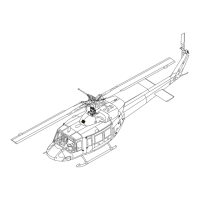BHT-212-MM-1
5-00-00
15 NOV 2018 Rev. 16 Page 123Export Classification C, ECCN EAR99
FOR INSPECTION OF THE BLADE ON THE
LOWER SIDE, THE BLADE MUST BE
SUPPORTED AT THE TIP TO REMOVE ANY BOW.
FAILURE TO SUPPORT THE BLADE
ADEQUATELY MAY RENDER CHORDWISE
CRACKS DIFFICULT TO DETECT.
2. Inspect the main rotor blade upper and lower grip plates
and doublers for their entire length and chord width. Inspect for
signs of cracks, corrosion, and edge voids, paying particular
attention to the bond lines between doublers, grip plates, and
skin. Hair line cracks in the paint finish should be suspect for
possible cracks/voids.
3. Wipe the area to be inspected with a clean cloth (C-516)
soaked with isopropyl alcohol (C-385). Wipe dry with a clean
cloth (C-516).
Accomplish step 4 immediately after carrying out the
above alcohol wipe. Any potential cracks in the bond
lines between doublers or grip plates will be
indicated by the presence of excess alcohol bleeding
out of an edge void. The excess alcohol in the void
will appear as a dark line between the bond lines of
the doublers.
When inspecting the blade for cracks, the strong light
source should be applied at an oblique angle and
perpendicular to the crack orientation we attempt to
detect. For example, for a chordwise crack, the light
source should be applied in a spanwise direction.
5-22. EACH 25 HOURS OF FLIGHT OPERATION (CONT)
DATA REFERENCE INSPECTION TASK DESCRIPTION
INITIAL
MECH OTHER

